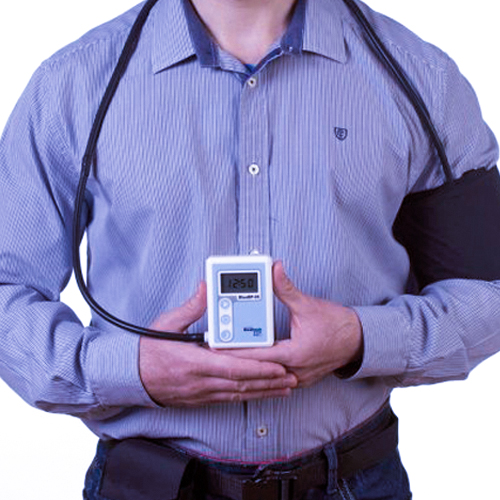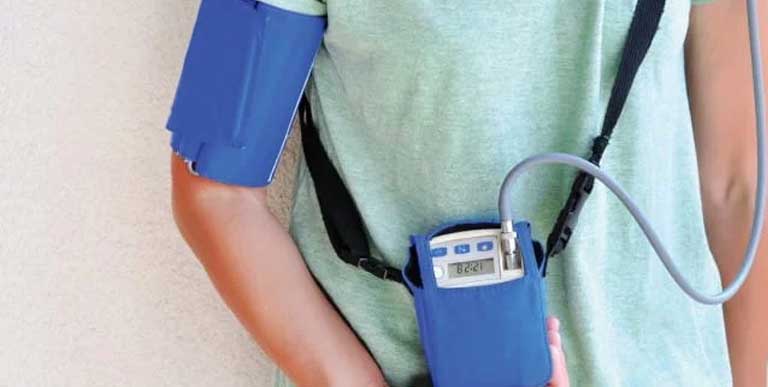Recognizing the Value of the ABPM Test in High Blood Pressure Administration
Ambulatory Blood Pressure Monitoring (ABPM) is an essential device in handling hypertension. By offering continual blood pressure readings over 24 hours, it supplies understandings that traditional measurements can not. This method can expose conditions such as white layer syndrome and masked hypertension. Comprehending these subtleties is crucial for efficient client treatment. As health care progresses, the effects of ABPM fit individualized therapy methods come to be significantly significant. What does this mean for the future of high blood pressure management?
What Is Ambulatory Blood Pressure Monitoring (ABPM)?
Ambulatory Blood Pressure Monitoring (ABPM) is a technique that permits the continual measurement of blood pressure over a 24-hour period while individuals participate in their daily tasks. This ingenious strategy includes the use of a mobile device that instantly takes blood pressure readings at set periods, normally every 15 to half an hour. ABPM provides an extensive profile of blood pressure fluctuations throughout the day and night, catching variations that might be missed out on during standard workplace measurements.It is especially advantageous for detecting conditions such as high blood pressure and white layer syndrome, where clients show elevated readings just in medical setups. By offering real-time data, ABPM improves the accuracy of hypertension evaluations and aids in tailoring therapy plans. The understandings acquired from this monitoring may bring about better monitoring of cardiovascular health, enhancing the value of ABPM in modern-day medical method.
Exactly How ABPM Varies From Traditional Blood Pressure Dimensions
While conventional blood pressure measurements normally rely on analyses taken in a professional setting, ABPM offers an extra extensive technique by examining blood pressure over a full 24-hour period. Traditional approaches frequently produce a minimal number of analyses that may not record fluctuations in blood pressure throughout the day. On the other hand, ABPM permits for constant monitoring, offering insights right into variants during different tasks, such as resting and exercising.Additionally, traditional measurements might be affected by the patient's stress and anxiety throughout a doctor's browse through, referred to as "white layer syndrome," possibly causing inaccurately high analyses. ABPM minimizes this issue by accumulating information in a familiar setting, producing a much more exact representation of a person's blood pressure. The device typically takes measurements at normal periods, making sure thorough data collection. This essential distinction highlights the value of ABPM in offering a complete photo of a patient's blood pressure account.
Benefits of ABPM in High Blood Pressure Administration
The use of Ambulatory Blood Pressure Monitoring (ABPM) presents significant advantages in taking care of hypertension. It uses accurate and constant blood pressure readings, assisting to recognize problems such as white coat disorder. This specific information enables doctor to make more individualized treatment modifications tailored to private person demands.
Exact Blood Pressure Monitoring

Determining White Coat Disorder
Ambulatory Blood Pressure Monitoring (ABPM) plays a substantial role in identifying white coat syndrome, a sensation where clients show elevated blood pressure readings in a scientific setup but preserve typical degrees in their daily lives. This condition can lead to misdiagnosis and unnecessary treatment, making complex hypertension administration. ABPM offers a complete evaluation of blood pressure over a 24-hour period, catching variants that occur during day-to-day tasks and rest. By contrasting these analyses to facility measurements, healthcare providers can compare true hypertension and white coat syndrome. Ultimately, acknowledging this disorder is crucial for customizing suitable treatment methods and avoiding overtreatment, guaranteeing that patients obtain treatment that properly mirrors their blood pressure standing outside the medical atmosphere.
Customized Treatment Adjustments
Enhancing high blood pressure monitoring via personalized therapy changes comes to be feasible with the understandings obtained from ABPM. This technique gives continual blood pressure monitoring, permitting doctor to determine patterns and variations that may not appear throughout standard office visits. By recognizing a client's other distinct blood pressure profile, medical professionals can tailor therapy plans that think about aspects such as medication efficiency, way of life influences, and specific response to therapy. This customized technique not just boosts person adherence but additionally improves overall results by reducing the threat of issues associated with uncontrolled hypertension. Inevitably, using ABPM equips clinicians to make enlightened decisions, resulting in more reliable administration strategies that straighten with each individual's particular demands.
Determining White Coat High Blood Pressure and Masked High Blood Pressure
White coat high blood pressure takes place when individuals exhibit raised blood pressure analyses in a scientific setup as a result of stress and anxiety, while their measurements are typical in other atmospheres. On the other hand, masked high blood pressure refers to individuals whose blood pressure is typical throughout clinical sees yet raised in daily life. Understanding these two phenomena is vital for accurate high blood pressure management and treatment choices.
Specifying White Layer Hypertension
High blood pressure administration commonly entails differentiating in between numerous blood pressure conditions, specifically white coat hypertension and covered up high blood pressure. White layer hypertension is identified by raised blood pressure readings in clinical settings, look these up usually as a result of stress and anxiety connected with medical settings. Patients with this problem usually display normal blood pressure levels beyond these setups. This phenomenon can bring about misdiagnosis and unneeded therapy if not appropriately determined. It is important for health care carriers to acknowledge this problem to avoid overtreatment and to guarantee exact hypertension administration. ABPM test in Bangalore. Using ambulatory blood pressure monitoring (ABPM) can assist distinguish white layer high blood pressure from continual high blood pressure, enabling more efficient and tailored therapy methods for individuals experiencing this unique blood pressure reaction
Comprehending Masked High Blood Pressure
Masked high blood pressure presents a substantial challenge in hypertension administration, as it often goes unnoticed in scientific setups. This problem happens when a client's blood pressure readings are normal during medical check outs yet elevated in the house or during daily activities. Unlike white coat hypertension, where anxiousness in a professional atmosphere causes temporary spikes in blood pressure, covered up hypertension can result in unrecognized cardiovascular dangers. People may believe they have normal blood pressure, disregarding required way of life changes or treatments. Determining covered up hypertension is vital, as it can cause major health problems over time. Ambulatory Blood Pressure Monitoring (ABPM) is an effective device for spotting this condition, making it possible for health care specialists to give timely intervention and boost individual results.
The Role of ABPM in Personalized Therapy Strategies
As doctor increasingly recognize the significance of individualized care, the application of Ambulatory Blood Pressure Monitoring (ABPM) has actually become important in tailoring treatment prepare for patients with hypertension. ABPM enables constant blood pressure dimension over 1 day, exposing patterns that may be missed during conventional office sees. This comprehensive information offers understandings into an individual's blood pressure variability and nighttime degrees, which are here crucial for comprehending total cardio threat.
Analyzing ABPM Outcomes: Understanding Patterns and Fads
Interpreting the arise from Ambulatory Blood Pressure Monitoring (ABPM) calls for an eager understanding of various patterns and patterns that emerge from the gathered data. Clinicians examine the 24-hour blood pressure profile, differentiating between daytime and nighttime readings to identify prospective white-coat hypertension or masked hypertension. A constant elevation in daytime analyses might suggest poorly regulated hypertension, while nighttime dips can indicate reliable blood pressure administration or nocturnal high blood pressure, which poses extra cardio risks.Trends gradually, such as continual rises or fluctuations, are also essential. Variability in readings can suggest underlying issues, such as tension or medicine non-adherence. Furthermore, the evaluation of blood pressure patterns in connection with daily tasks can provide understandings into way of life elements impacting high blood pressure. By thoroughly translating these outcomes, health care specialists can customize therapy strategies to boost person results in hypertension management, inevitably leading to much better cardio health and wellness.
The Future of Blood Pressure Monitoring and Hypertension Care
Arising technologies and technologies are positioned to change blood pressure monitoring and hypertension treatment in the coming years. Wearable tools geared up with innovative sensors are expected to offer continuous, real-time blood pressure analyses, enabling more tailored treatment programs. These devices will not only boost patient interaction but also assist in remote monitoring by doctor, causing timely interventions.Artificial knowledge and equipment knowing algorithms will certainly play a necessary function in evaluating client data, determining fads, and forecasting hypertension-related complications. This anticipating capacity can lead to more aggressive management techniques. Additionally, telehealth solutions will likely expand, enabling individuals to seek advice from specialists and obtain customized recommendations without the need for in-person visits.Furthermore, advancements in mobile applications may equip patients to track their blood pressure separately, fostering a sense of ownership over their health. Generally, the future of blood pressure monitoring and high blood pressure treatment appears promising, with technology at its leading edge.
Frequently Asked Questions

The length of time Does an ABPM Test Typically Last?
The ABPM examination normally lasts 24 hr. Throughout this period, a portable gadget actions blood pressure at regular periods, offering extensive data on an individual's blood pressure patterns throughout daily tasks and rest.
Can ABPM Be Used for Youngsters and Teenagers?
ABPM can without a doubt be made use of for youngsters and teenagers - ABPM test in Bangalore. It gives important insights into their blood pressure patterns, assisting healthcare providers accurately diagnose and handle hypertension in younger populations, promoting much better lasting wellness end results

What Should I Prevent Prior To Taking an ABPM Test?

Prior to taking an ABPM test, individuals need to avoid caffeine, pure nicotine, and arduous workout, as these can momentarily elevate blood pressure analyses. Furthermore, it's suggested to avoid wearing limited clothing that might impede dimension accuracy.
Exactly how Usually Should I Undergo ABPM Screening?
The regularity of ABPM testing varies based upon specific health and wellness requirements. Generally, it is advised every six to twelve months, especially for those with uncontrolled hypertension or significant modifications in blood pressure medicine. Normal monitoring aids effective administration.
Is ABPM Covered by Insurance Coverage Plans?
The coverage of ABPM screening by insurance coverage plans varies considerably. People need to consult their details insurance policy providers to figure out eligibility and any kind of prospective out-of-pocket expenses associated with this diagnostic treatment for hypertension monitoring.